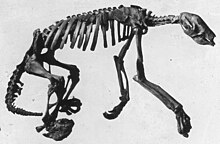Nothrotheriidae
| Nothrotheriidae | |
|---|---|

| |
| Preguiça de Shasta (Nothrotheriops shastense), Peabody Museum of Natural History | |
| Classificação científica | |
| Domínio: | Eukaryota |
| Reino: | Animalia |
| Filo: | Chordata |
| Classe: | Mammalia |
| Ordem: | Pilosa |
| Clado: | †Megatheria |
| Família: | †Nothrotheriidae (Ameghino 1920) C. de Muizon et al. 2004 |
| Genera | |
| |
A família Nothrotheriidae é uma das famílias das preguiças-gigantes ou preguiças-terrícolas, um grupo de mamíferos pré-históricos que habitaram as Américas.[7] Em conjunto com diversos outros animais compunham a megafauna do continente.[8] Viveram entre 17.5M - 10.000 anos atrás. Previamente eram posicionados na família Megatheriidae,[9] agora são sua própria família. E embora fossem menores que esses seus parentes, suas garras ainda eram uma efetiva forma de defesa contra predadores,[10] como nas preguiças e tamanduás modernos Havia um gênero de preguiças semi-aquáticas nos Nothroriidae,[11] os Thalassocnus.[12]
Referências[editar | editar código-fonte]
- ↑ Amson, E.; de Muizon, C.; Gaudin, T. J. (2017). «A reappraisal of the phylogeny of the Megatheria (Mammalia: Tardigrada), with an emphasis on the relationships of the Thalassocninae, the marine sloths» (PDF). Zoological Journal of the Linnean Society. 179 (1): 217–236. doi:10.1111/zoj.12450
 . Cópia arquivada (PDF) em 12 de junho de 2018
. Cópia arquivada (PDF) em 12 de junho de 2018
- ↑ Varela, L.; Tambusso, P.S.; McDonald, H.G.; Fariña, R.A.; Fieldman, M. (2019). «Phylogeny, Macroevolutionary Trends and Historical Biogeography of Sloths: Insights From a Bayesian Morphological Clock Analysis». Systematic Biology. 68 (2): 204–218. PMID 30239971. doi:10.1093/sysbio/syy058
- ↑ A 2017 phylogenetic study moves this subfamily to Megatheriidae,[1] while a 2019 study retains it in Nothrotheriidae.[2]
- ↑ PUJOS, FRANçOIS; DE IULIIS, GERARDO; MAMANI QUISPE, BERNARDINO; ADNET, SYLVAIN; ANDRADE FLORES, RUBEN; BILLET, GUILLAUME; FERNáNDEZ-MONESCILLO, MARCOS; MARIVAUX, LAURENT; MüNCH, PHILIPPE; PRáMPARO, MERCEDES B.; ANTOINE, PIERRE-OLIVIER (1 de novembro de 2016). «A new nothrotheriid xenarthran from the early Pliocene of Pomata-Ayte (Bolivia): new insights into the caniniform-molariform transition in sloths». Zoological Journal of the Linnean Society. 178 (3): 679–712. ISSN 0024-4082. doi:10.1111/zoj.12429
- ↑ François Pujos, Gerardo De Iuliis, Bernardino Mamani Quispe & Ruben Andrade Flores (2014) Lakukullus anatisrostratus, gen. et sp. nov., a new massive nothrotheriid sloth (Xenarthra, Pilosa) from the middle Miocene of Bolivia,Journal of Vertebrate Paleontology, 34:5,1243-1248, DOI: 10.1080/02724634.2014.849716
- ↑ Gaudin, T. J.; Boscaini, A.; Mamani Quispe, B.; Andrade Flores, R.; Fernández-Monescillo, M.; Marivaux, L.; Antoine, P.-O.; Münch, P.; Pujos, F. (2022). «Recognition of a new nothrotheriid genus (Mammalia, Folivora) from the early late Miocene of Achiri (Bolivia) and the taxonomic status of the genus Xyophorus». Historical Biology: An International Journal of Paleobiology. doi:10.1080/08912963.2022.2075744
- ↑ STEADMAN, D. W. et al. Asynchronous extinction of late Quaternary sloths on continents and islands. Proceedings of the National Academy of Sciences of the United States of America, v. 102, n. 33, p. 11763–11768, 2005.
- ↑ Fariña, Richard A.; Vizcaíno, Sergio F.; Iuliis, Gerry De (22 de maio de 2013). Megafauna: Giant Beasts of Pleistocene South America (em inglês). [S.l.]: Indiana University Press
- ↑ De Muizon, Christian; Mcdonald, H. Gregory; Salas, Rodolfo; Urbina, Mario (11 de junho de 2004). «The youngest species of the aquatic sloth Thalassocnus and a reassessment of the relationships of the nothrothere sloths (Mammalia: Xenarthra)». Journal of Vertebrate Paleontology (2): 387–397. ISSN 0272-4634. doi:10.1671/2429a. Consultado em 22 de dezembro de 2022
- ↑ «Locomotory patterns within the Pleistocene sloths - ProQuest». www.proquest.com. Consultado em 22 de dezembro de 2022
- ↑ Mcdonald, H. Gregory; De Muizon, Christian (8 de julho de 2002). «The cranial anatomy of Thalassocnus (Xenarthra, Mammalia), a derived nothrothere from the Neogene of the Pisco Formation (Peru)». Journal of Vertebrate Paleontology (2): 349–365. ISSN 0272-4634. doi:10.1671/0272-4634(2002)022[0349:TCAOTX]2.0.CO;2. Consultado em 22 de dezembro de 2022
- ↑ Muizon, C. De; Mcdonald, H.G.; Salas, R.; Urbina, M. (2004). «The evolution of the feeding adaptations in the aquatic sloths (Thalassocnus, Nothrotheriidae) of the Pisco Formation (Neogene of Peru).». Journal of Vertebrate Paleontology: 401–413. Consultado em 22 de dezembro de 2022

